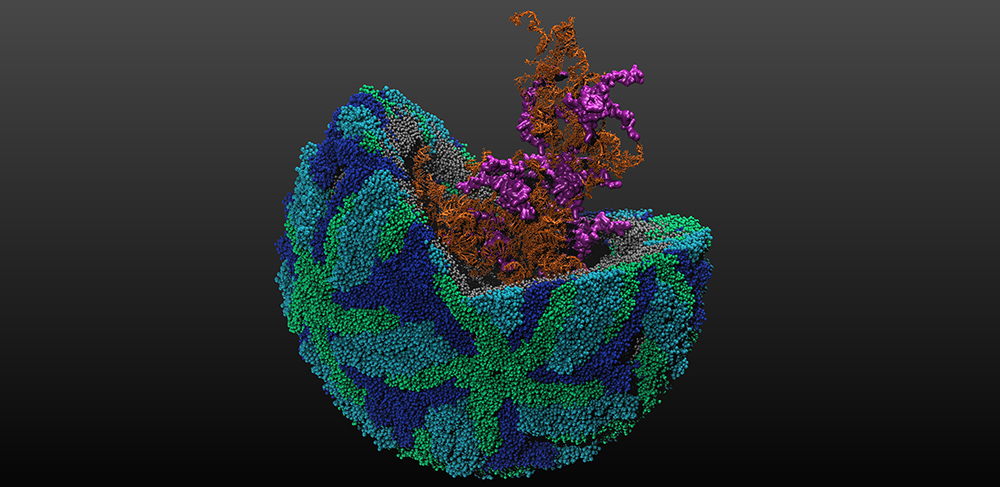A*STAR NEWS
PRESS RELEASES
Unveiling the Map to Designing Treatments for Dengue and Zika Viruses
MEDIA RELEASE
FOR IMMEDIATE RELEASE
24 APRIL 2019
Schematic representation of mature and infectious dengue virus
(Copyright: A*STAR’s Genome Institute of Singapore)
Singapore – Scientists from the Agency for Science- Technology and Research’s (A*STAR) Genome Institute of Singapore (GIS)- together with scientists from Duke-NUS Medical School and A*STAR’s Bioinformatics Institute (BII)- have mapped out the structures of four dengue and four Zika viruses. The research focuses on understanding the genetic materials and shapes of these viruses- as well as their corresponding functions. Consequently- understanding their biology enables scientists to design better drugs and treatments.
Mosquito-borne infections are common and deadly in tropical and subtropical regions around the world. Estimates suggest up to 700 million infections and over one million deaths are caused by a variety of mosquito-borne viruses yearly 1. One major class of mosquito-borne viruses are the Flaviviruses2- which include the dengue and Zika viruses.
Dengue is a well-known virus which affects more than 390 million people around the world. Singapore is one of the major hotspots of dengue infection3. Every year- 2-000 to 3-000 people are affected by dengue in Singapore4. Whilst most of these cases are fairly mild- dengue-associate deaths still occur each year. While the Zika virus has generally limited severity in healthy adults- there has been greater public interest due to the Zika epidemic from 2015 to 2016- and reports of adverse health effects observed in South America5.
Using structure probing- the scientists mapped the long genetic materials of four dengue and four Zika virus strains. The research studied the viruses’ activities and vital parts to identify portions of the viruses’ genetic materials that could be targeted for treatments. Through the identification of the common shapes and structures of the viruses- scientist will be able to design new drug treatments to target these areas.
Dr Wan Yue- Principal Investigator at A*STAR’s GIS and lead author of the study- said- “One needs to understand the shape and mechanism of a lock- in order to design a key that can open it. Similarly- mapping the shapes and structures of the dengue and Zika viruses will boost understanding of their biology- and contribute significantly towards designing drug treatments targeted at these viruses.”
“Moving ahead- additional research needs to be performed to better understand how the viruses’ structural mutations reduce their effect. It will also identify the roles that different structures play during their lifecycles-” she added.
Dr Roland G. Huber- Assistant Principal Investigator at A*STAR’s BII- said- “Understanding the structures of these viruses required us to develop innovative techniques to find synergies in the vast amount of data generated for this study. We developed new tools that will allow us to better understand the architecture of these and other viruses in the future. A strong team of researchers with complementary skills enabled us to succeed.”
Professor Ng Huck Hui- Executive Director at A*STAR’s GIS- said- “The collaborative study with BII and Duke-NUS unravels significant information on the genetics of the dengue and Zika viruses. This is a crucial step towards designing targeted therapeutics to tackle the diseases.”
The study was published in Nature Communications on 29 March 2019.
1Source: “Emergency department management of mosquito-borne illness: malaria- dengue- and West Nile virus” https://europepmc.org/abstract/med/25207355
2Flaviviruses: A family of positive- single-stranded- enveloped RNA viruses found in arthropods- (primarily ticks and mosquitoes)- and can occasionally infect humans. (Source: CDC https://www.cdc.gov/vhf/virus-families/flaviviridae.html)
3Source: “The global distribution and burden of dengue” https://www.ncbi.nlm.nih.gov/pmc/articles/PMC3651993/
4Source: The Straits Times
5Source: CDC https://www.cdc.gov/zika/about/index.html
Notes to Editor:
The research findings described in this media release can be found in the scientific journal Nature Communications- under the title- “Structure mapping of dengue and Zika viruses reveals functional long-range interactions” by Roland G. Huber1*- Xin Ni Lim2*- Wy Ching Ng3*- Adelene Y. L. Sim1*- Hui Xian Poh2- Yang Shen4- Su Ying Lim2- Karin B. Sundstrom3- Xuyang Sun5-6- Jong Ghut Aw2- Horng Khit Too7-8- Peng Hee Boey7-8- Andreas Wilm4- Tanu Chawla3- Ming M. Choy9- Lu Jiang10-11- Paola Florez de Sessions12- Xian Jun Loh10-11- Sylvie Alonso7-8- Martin Hibberd9- Niranjan Nagarajan4- Eng Eong Ooi3- Peter J. Bond1†- October M. Sessions3-13-14†- Yue Wan2-15-16†.
1. Bioinformatics Institute (A*STAR)- 30 Biopolis Street #07-01- Matrix- 138671- Singapore
2. Stem Cell and Regenerative Biology- Genome Institute of Singapore- Singapore 138672- Singapore
3. Program in Emerging Infectious Diseases- Duke-NUS Graduate Medical School- 8 College Road- 169857- Singapore.
4. Computational Biology- Genome Institute of Singapore- Singapore 138672
5. Department of Neurology- National Neuroscience Institute- 20 College Road- Singapore 169856- Singapore.
6. Stem Cell and Regenerative Biology- Genome Institute of Singapore- 60 Biopolis Street- Singapore 138672- Singapore
7. Department of Microbiology and Immunology- Yong Loo Lin School of Medicine- National University of Singapore- Singapore.
8. Immunology programme- Life Sciences Institute- National University of Singapore- Singapore.
9. Infectious Diseases- Genome Institute of Singapore- Singapore; Pathogen Molecular Biology- London School of Hygiene & Tropical Medicine- London- UK.
10. Institute of Materials Research and Engineering (IMRE)- A*STAR- Singapore 138634
11. Department of Materials Science and Engineering- National University of Singapore
12. GERMS platform- Genome Institute of Singapore- Singapore 138672
13. Saw Swee Hock School of Public Health- National University of Singapore- Singapore 117549
14. Department of Pharmacy- National University of Singapore- Singapore 117559
15. School of Biological Sciences- Nanyang Technological University- Singapore
16. Department of Biochemistry- Yong Loo Lin School of Medicine- National University of Singapore- Singapore 117597- Singapore
* These authors contributed equally.
Ɨ Correspondence should be addressed to: Y.W. (wany@gis.a-star.edu.sg)- O.S.
(october.sessions@duke-nus.edu.sg) or P.B. (peterjb@bii.a-star.edu.sg)
About A*STAR’s Genome Institute of Singapore (GIS)
The Genome Institute of Singapore (GIS) is an institute of the Agency for Science- Technology and Research (A*STAR). It has a global vision that seeks to use genomic sciences to achieve extraordinary improvements in human health and public prosperity. Established in 2000 as a centre for genomic discovery- the GIS will pursue the integration of technology- genetics and biology towards academic- economic and societal impact.
The key research areas at the GIS include Human Genetics- Infectious Diseases- Cancer Therapeutics and Stratified Oncology- Stem Cell and Regenerative Biology- Cancer Stem Cell Biology- Computational and Systems Biology- and Translational Research.
The genomics infrastructure at the GIS is utilised to train new scientific talent- to function as a bridge for academic and industrial research- and to explore scientific questions of high impact.
For more information about GIS
About the Agency for Science- Technology and Research (A*STAR)
The Agency for Science- Technology and Research (A*STAR) is Singapore's lead public sector agency that spearheads economic oriented research to advance scientific discovery and develop innovative technology. Through open innovation- we collaborate with our partners in both the public and private sectors to benefit society.
As a Science and Technology Organisation- A*STAR bridges the gap between academia and industry. Our research creates economic growth and jobs for Singapore- and enhances lives by contributing to societal benefits such as improving outcomes in healthcare- urban living- and sustainability.
We play a key role in nurturing and developing a diversity of talent and leaders in our Agency and research entities- the wider research community and industry. A*STAR’s R&D activities span biomedical sciences and physical sciences and engineering- with research entities primarily located in Biopolis and Fusionopolis. For ongoing news- visit www.a-star.edu.sg.
Was This Article Helpful?
A*STAR celebrates International Women's Day

From groundbreaking discoveries to cutting-edge research, our researchers are empowering the next generation of female science, technology, engineering and mathematics (STEM) leaders.
Get inspired by our #WomeninSTEM

